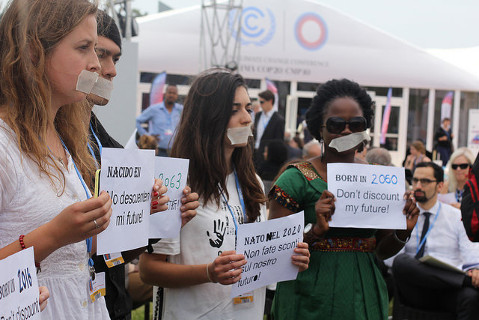Climate Change Talks Drag On in Lima
While Super Typhoon Roars Across Pacific

Trudging along through the muggy heat of Lima at the ongoing UN Climate Conference, nothing would indicate that we were standing at an international meeting slated to respond to a worldwide emergency. Delegates lounged at tables on the grass, under the shade of trees, conducting interviews and swapping notes about the latest plenary. Ironically, the heat seems to make the negotiations move more slowly.
I arrived in Lima a week ago as an observer delegate with SustainUS for the 20th Conference of the Parties (COP), under the United Nations Framework Convention on Climate Change (UNFCCC). COP20 is possibly the most important climate conference thus far since the work done here goes to Paris for COP21. There, countries are slated to sign a treaty that outlines mitigation, adaptation, and finance from 2015 to 2020, and another set of agreements for post-2020. Paris is hoped to be the next Copenhagen — the previous treaty-signing conference — but it is unlikely we’ll see the results we want to see. At Lima, the discussions and tentative commitments make it obvious that the results in Paris will not satisfy the needs of global societies.
In November 2014, the United States and China announced a historical and unexpected agreement to make their own pledges for emissions reductions. It was a fantastic moment — Obama set his legacy that day to be a climate leader, and he set stage for COP20 by urging other countries to do the same. But, sadly, it’s not enough; including the new U.S.-China pledges, we’re still on track for a 4-6 degree (centigrade) warmer world. The U.S. commitment in particular would only cut emissions in 2025 to 14 percent of 1990’s levels (the global standard). Many nongovernmental organizations (NGOs) are latching onto this agreement as a tiny glimmer of hope; but science and math show that it will not deliver anywhere near the level of ambition needed.
It’s becoming painfully clear that the intention of the most powerful groups is to push for an agreement — any agreement — to avoid another “Nopenhagen.” The orchestrator of this trend is the Obama administration; Obama has made it disturbingly clear that he wants a treaty agreement in Paris, no matter the content, and he wants it to focus on mitigation, or reducing greenhouse gas emissions. Yet the proposals that he and the Umbrella Group (which includes the U.S., Australia, Canada, and other powerful countries) are putting forward would mean “game over” for the planet and the most vulnerable communities. In addition to the lack of adaptation and finance — both needed for those facing inundation or famine — under this push for an agreement, developed countries are finding loopholes to avoid ambitious emissions cuts. In March 2015, countries will submit Intended Nationally Determined Contribution (INDC) for their intended pledges in Paris, which will focus solely on mitigation and allow for countries to choose how much they want to put forward. This will fail to put us on track to stay within 1.5°C of warming.
But it’s not only mitigation that’s in trouble; there is a huge rift between the developed, developing, and least-developed countries (LDCs). The Umbrella Group, which is pushing hard for a mitigation-focused agreement, has been historically responsible for the bulk of emissions and is not yet experiencing the worst impacts of climate change. Developing countries and LDCs are instead pushing for adaptation and finance for loss and damage, so that they might have a fighting chance in the global economic arena. Rightly so, they are hesitant to pledge the emissions cuts the Umbrella Group is pushing for if they are not guaranteed to have the financial support to implement adaptation. Many of the poorest countries are the ones that could be most affected by the impacts of climate change. By ignoring this demand, the Umbrella Group and its associates are condemning hundreds of millions of people to unconscionable suffering.
Meanwhile …
During each of the last four COPs, the Philippines have been struck by typhoons. Typhoon Haiyan, which struck the Philippines last year during COP19, was the most devastating typhoon to ever hit land. It left an enormous swath of damage, and killed a total of 6,340 people. Yeb Sano, negotiator for the Philippines, delivered the Philippines’ opening speech on the first day of COP19; at that time, he did not know where his brother was. This year, Yeb has not returned. Typhoon Ruby is on track to hit the Philippines this weekend and has reached the status of “superstorm”. Many fear that it will have the same impact as Haiyan, if not worse.
The Maldives are experiencing an increasing rate of storm surges and damaging sea level rise. Large areas in Africa are undergoing extensive drought, killing livestock and crops. More and more people are becoming classified as climate refugees. Adaptation and finance is necessary for these countries, but as long as the Umbrella Group dictates the negotiations, they will never see the assistance they need from these UN Framework Conventions.
When you walk around the COP, listen in on the plenaries and negotiations, and read the materials that countries are providing, you don’t get the sense that this conference was scheduled to respond to a planetary emergency. It’s possible that people were just exhausted — not from the heat or the discussions, but because the conference halls ringed a fútbol stadium and delegates averaged 10 laps a day. The sluggish pace of the conversation meant human deaths, the discounting of youth and future generations, and the real impacts on oceans, forests, and wildlife were treated as simple statistics and trading cards. It is institutionalized insanity, and one has to wonder how the connection between reality and the bubble that is COP has become white noise. In Yeb Sano’s words, “It is time to stop this madness.”
Emily Williams is a UCSB alum who works with the California Student Sustainability Coalition.



